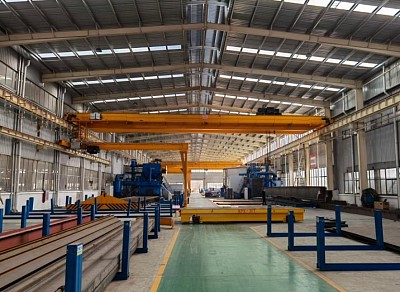Overhead and Gantry Cranes
The Differences, Applications, and Benefits of Overhead Cranes and Gantry Cranes
Material handling is a critical aspect of modern industries, from manufacturing and logistics to construction and shipbuilding. Among the most commonly used lifting equipment are overhead cranes and gantry cranes, both of which play vital roles in ensuring efficiency, safety, and precision in heavy-duty lifting operations. While these cranes share similarities, they also differ in design, structure, and application. Understanding these differences can help businesses select the most suitable crane for their needs.
What is an Overhead Crane?
An overhead crane for sale, sometimes referred to as a bridge crane, is a type of lifting equipment installed inside a building or factory. It consists of parallel runways with a traveling bridge that spans the gap. The lifting mechanism, known as the hoist, travels along the bridge, enabling the crane to move loads in three directions: up and down, side to side, and forward and backward.
Overhead cranes are fixed installations inside workshops, factories, or warehouses. They are designed for high lifting capacities, which can range from a few tons to several hundred tons, depending on industry requirements. There are different types of overhead cranes, such as single girder, double girder, top-running, and under-running cranes. These cranes are particularly valued for their precision and reliability, making them suitable for industries that require accurate load handling.
Typical applications of overhead cranes include manufacturing plants for assembling heavy components, steel mills for handling coils, plates, and billets, power stations for lifting turbines, generators, and transformers, as well as warehouses and logistics centers where materials need to be efficiently stored or moved.
What is a Gantry Crane?
A gantry crane for sale is similar in design to an overhead crane but is supported by freestanding legs that run on wheels or rails at ground level. Unlike overhead cranes, gantry cranes do not require a building structure for installation, which makes them highly versatile for both outdoor and indoor operations.
Gantry cranes are freestanding and can be mobile, depending on their design. Some are rail-mounted (RMG cranes), while others use rubber tires (RTG cranes) for flexibility in movement. They come in a wide range of sizes, from small portable gantry cranes suitable for workshops to massive ship-to-shore container cranes used in ports. Their flexible installation means they can be used temporarily on construction sites or permanently in industrial yards.
Common applications of gantry cranes include ports and shipyards for container handling and vessel maintenance, construction sites for lifting beams, precast concrete, and heavy materials, outdoor storage yards for steel and stone, as well as boat manufacturing and repair facilities using mobile boat hoists.
Overhead Crane vs. Gantry Crane: Key Differences
Although overhead cranes and gantry cranes share the same purpose of lifting and moving heavy loads, there are several important differences between them.
Overhead cranes are fixed installations inside a building and rely on runway beams supported by the building’s structure. In contrast, gantry cranes are freestanding and supported by their own legs, which makes them less dependent on existing infrastructure. This distinction means that overhead cranes are more suitable for indoor use, whereas gantry cranes are often the better choice for outdoor environments or situations where mobility is required.
From a mobility standpoint, overhead cranes are stationary within the building they are installed in, while gantry cranes can be rail-mounted or rubber-tired, allowing for significant flexibility. In terms of application, overhead cranes are more commonly seen in indoor manufacturing and heavy industry facilities, while gantry cranes dominate outdoor yards, ports, shipyards, and construction sites.
When it comes to cost considerations, overhead cranes often require building reinforcement and permanent infrastructure, while gantry cranes generally have lower infrastructure requirements. Finally, in terms of flexibility, overhead cranes tend to be permanent solutions, whereas gantry cranes can be portable or semi-permanent, depending on operational needs.
Benefits of Using Overhead and Gantry Cranes
Both overhead and gantry cranes bring numerous advantages to industrial operations. They improve efficiency by reducing manual labor and speeding up material handling. Safety is another significant benefit, as these cranes are equipped with features such as limit switches, overload protection, and anti-sway systems.
From a cost perspective, investing in these cranes is highly effective in the long run, as they help minimize downtime and maximize productivity. Moreover, they can be customized to meet specific lifting requirements, including capacity, span, lifting height, and control methods. Their versatility also makes them suitable for a wide variety of industries, from steel manufacturing and power plants to shipyards and construction projects.
Choosing the Right Crane for Your Needs
Selecting between an overhead crane and a gantry crane depends on several factors. These include the location of operation (whether indoor or outdoor), the required lifting capacity and span, the frequency of use, and the available budget and infrastructure. Another crucial factor is mobility — some businesses may require a fixed solution, while others may benefit from the portability of a gantry crane.
For example, a steel manufacturing plant may find that an overhead crane provides the precision and reliability needed for continuous indoor operations. On the other hand, a port or outdoor storage yard may require the flexibility of a gantry crane to handle heavy containers or materials efficiently.
Conclusion
Overhead cranes and gantry cranes are indispensable tools for industries that demand safe and efficient handling of heavy materials. While overhead cranes excel in fixed indoor environments, gantry cranes provide unmatched flexibility for outdoor and mobile applications. By understanding their features, applications, and differences, companies can make informed decisions that enhance productivity, safety, and cost efficiency in their operations.

